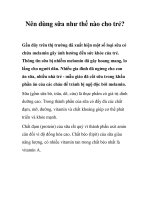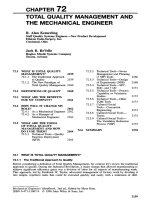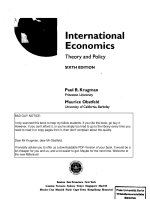Tài liệu Social Learning Theory and the Health Belief Model pptx
Bạn đang xem bản rút gọn của tài liệu. Xem và tải ngay bản đầy đủ của tài liệu tại đây (536.2 KB, 9 trang )
175-1
Social
Learning
Theory
and
the
Health
Belief
Model
Irwin
M.
Rosenstock,
PhD
Victor
J.
Strecher,
PhD,
MPH
Marshall
H.
Becker,
PhD,
MPH
Irwin
M.
Rosenstock
is
FHP
Endowed
Professor
and
Director,
Center
for
Health
and
Behavior
Studies,
California
State
University,
Long
Beach.
Victor
J.
Strecher
is
Assistant
Professor,
Department
of
Health
Education,
Univer-
sity
of
North
Carolina.
Marshall
H.
Becker
is
Professor,
Department
of
Health
Behavior
and
Health
Educa-
tion,
The
University
of
Michigan.
Address
reprint
requests
to
Irwin
M.
Rosenstock,
PhD,
Center
for
Health
and
Be-
havior
Studies,
School
of
Applied
Arts
and
Sciences,
California
State
University,
Long
Beach,
1250
Bellflower
Boulevard,
Long
Beach,
CA
90840.
The
Health
Belief
Model,
social
learning
theory
(recently
relabelled
social
cognitive
theory),
self-efficacy,
and
locus
of
control
have
all
been
applied
with
varying
success
to
problems
of
explaining,
predicting,
and
influencing
behavior.
Yet,
there
is
con-
ceptual
confusion
among
researchers
and
practitioners
about
the
interrelationships
of
these
theories
and
variables.
This
article
attempts
to
show
how
these
explanatory
fac-
tors
may
be
related,
and
in
so
doing,
posits
a
revised
explanatory
model
which
incor-
porates
self-efficacy
into
the
Health
Belief
Model.
Specifically,
self-efficacy
is
pro-
posed
as
a
separate
independent
variable
along
with
the
traditional
health
belief
var-
iables
of
perceived
susceptibility,
severity,
benefits,
and
barriers.
Incentive
to
behave
(health
motivation)
is
also
a
component
of the
model.
Locus
of
control
is
not
included
explicitly
because
it
is
believed
to
be
incorporated
within
other
elements
of
the
model.
It
is
predicted
that
the
new
formulation
will
more
fully
account
for
health-related
behavior than
did
earlier
formulations,
and
will
suggest
more
effective
behavioral
interventions
than
have
hitherto
been
available
to
health
educators.
INTRODUCTION
In
recent
years
there
has
been
a
gradual
development
of
models
to
explain
and
modify
behavior.
These
models
reflect
a
confluence
of
learning
theories
derived
from
two
major
sources:
&dquo;Stimulus
Response&dquo;
(SR)
theory’-3
and
&dquo;Cognitive
Theory&dquo;.4-9
SR
theory
itself
represents
a
marriage
of
classical
conditioninglo
and
instrumental
conditioning’
theories.
In
simplest
terms,
the
SR
theorists
believe that
learning
results
from
events
(termed
&dquo;reinforcements&dquo;)
which
reduce
physiological
drives
that
activate
behavior.
In
the
case
of
pu.nislunents,
behavior
that
avoids
punishment
is
learned
because
it
reduces
the
tension
set
up
by
the
punishment.
The
concept
of
drive
reduction,
however,
is
not
176
necessary
to
the
theory.
Skinner’
1 formulated
the
widely
accepted
hypothesis
that
the
frequency
of
a
behavior
is
determined
by
its
consequences
(i.e.,
reinforcements).
For
Skinner,
the
mere
temporal
association
between
a
behavior
and
an
immediately-follow-
ing
reward
is
sufficient
to
increase
the
probability
that
the
behavior
will
be
repeated.
Such
behaviors
are
termed
operants;
they
operate
on
the
environment
to
bring
about
changes
resulting
in
reward
or
reinforcement.
In
this
view,
no
mentalistic
concepts
such
as
&dquo;reasoning&dquo;
or
&dquo;thinking&dquo;
are
required
to
explain
behavior.
While
Skinner
does
not
deny
the
existence
of
the
mind,
he
believes
that
behavioral
response
can
be
fully
explained
by
reinforcement
contingencies
alone.
Cognitive
theorists
emphasize
the
role
of
subjective
hypotheses
or
expectations
held
by
the
subject.
Behavior,
in
this
perspective,
is
a
function
of
the
subjective
value
of
an
outcome
and
of
the
subjective
probability
(or
&dquo;expectation&dquo;)
that
a
particular
action
will
achieve
that
outcome.
Such
formulations
are
generally
termed
&dquo;value-
expectancy&dquo;
theories.
Reinforcements,
or
consequences
of
behavior,
are
believed
to
operate
by
influencing
expectations
(or
hypotheses)
regarding
the
situation.
SOCIAL
LEARNING
THEORY
The
social
learning
theories
of
Rotter’
and
Bandura’
3-1
reflect
and
are
derived
from
these
views.
Bandura’s
social
learning
theory
(SLT),’
which
he
has
recently
relabelled
social
cognitive
theory
(SCT),&dquo;
holds
that
behavior
is
determined
by
expectancies
and
incentives:
(1)
Expectancies
For
heuristic
purposes
these
may
be
divided
into
three
types:
(a)
Expectancies
about
environmental
cues
(that
is,
beliefs
about
how
events
are
connected- about
what
leads
to
what).
~ (b)
Expectancies
about
the
consequences
of
one’s
own
actions
(that
is,
opin-
ions
about
how
individual
behavior
is
likely
to
influence
outcomes).
This
is
termed
outcome
expectation.
(c)
Expectancies
about
one’s
own
competence
to
perform
the
behavior
needed
to
influence
outcomes.
This
is
termed
efficacy
expectation
(i.e.,
self-efficacy).
(2)
Incentives
Incentive
(or
reinforcement)
is
defined
as
the
value
of
a
particular
object
or
outcome.
The
outcome
may
be
health
status,
physical
appearance,
approval
of
others,
economic
gain,
or
other
consequences.
Behavior
is
regulated
by
its
consequences
(reinforcements),
but
only
as
those
consequences
are
interpreted
and
understood
by
the
individual.
Thus,
for
example,
individuals
who
value
the
perceived
effects
of
changed
life-
styles
(incentives)
will
attempt
to
change
if
they
believe
that
(a)
their
current
lifestyles
pose threats
to
any
personally
valued
outcomes,
such
as
health
or
appearance
(environ-
mental
cues);
(b)
that
particular
behavioral
changes
will
reduce
the
threats
(outcome
expectations);
and
(c)
that
they
are
personally
capable
of
adopting
the
new
behaviors
(efficacy
expectations).
177
THE
HEALTH
BELIEF
MODEL
The
Health
Belief
Model
(HBM)IÓ-18
hypothesizes
that health-related
action
de-
pends
upon
the
simultaneous
occurrence
of
three
classes
of
factors:
(1)
The
existence
of
sufficient
motivation
(or
health
concern)
to
make
health
issues
salient
or
relevant.
(2)
The
belief
that
one
is
susceptible
(vulnerable)
to
a
serious
health
problem
or
to
the
sequelae
of
that
illness
or
condition.
This
is
often
termed
perceived
threat.
(3)
The
belief
that
following
a
particular
health
recommendation
would
be
bene-
ficial
in
reducing
the
perceived
threat,
and
at
a
subjectively-acceptable
cost.
Cost
refers
to
perceived
barriers
that
must
be
overcome
in
order
to
follow
the
health
recommendation;
it
includes,
but
is
not
restricted
to,
financial
outlays.
THE
HBM
AND
SCT
We
will
hereafter
use
Bandura’s
preferred
label
of
social
cognitive
theory
(SCT)
in
comparing
his
concepts
with
the
HBM.
It
has
been
noted
by
a
number
of
authors&dquo;.*20
that
the
HBM
is
closely
related
to
SCT.
This
is
hardly
surprising
because
much
of
the
development
of
&dquo;value-expectancy&dquo;
theory
(of
which
the
Health
Belief
Model
is
an
example)
as
well
as
social
learning
(or
cognitive)
theory
builds
upon
the
seminal
work
of
Tolman’
and
Kurt
Lewin.ó-9
Accordingly,
considerable
overlap
should
be
ex-
pected.
The
similarity
of
the
HBM
and
Bandura’s
social
cognitive
concepts
may
be
illustra-
ted
in
the
following
diagram:
CONCEPTS
Social
Cognitive
Theory
Expectancies
about
environmental
cues
Expectations
about
outcomes
(Social
Cognitive
Theory
does
not
explicitly
include
costs
or
barriers)
Expectations
about
self-efficacy
Incentive
Health
Belief Model
Perceived
susceptibility
to
and
severity
of
illness
or
its
sequelae
(threat)
Perceived
benefits
of
taking
a
particu-
lar
action
minus
perceived
costs
or
barriers
to
action
(Not
explicitly
included
in
Health
Be-
lief
Model
though
implied
in
&dquo;per-
ceived
barriers&dquo;)
Health
motive:
value
of
reduction
of
perceived
threats
Social
cognitive
theory
has
made
at
least
two
contributions
to
explanations
of
health-related
behavior
that
were
not
included
in
the
HBM.
The
first
is
the
emphasis
on
the
several
sources
of
information
for
acquiring
expectations,13 ,’
particularly
on
178
the
informative
and
motivational
role
of
reinforcement
and
on
the
role
of
observa-
tional learning
through
modeling
(imitating)
the
behavior
of
others.
The
delineation
of
sources
of
expectations
suggests
a
number
of
potentially-effective
strategies
for
alter-
ing
behavior
through
modifying
expectations.
A
second
major
contribution
is
the
introduction
of
the
concept
of
self-efficacy
(efficacy
expectation)
as
distinct
from
outcome
expectation.13-15,21
Outcome
ex-
pectation
(defined
as a
person’s
estimate
that
a
given
behavior
will
lead
to
certain
out-
comes)
is
quite
similar
to
the
HBM
concept
of
&dquo;perceived
benefits.&dquo;
Efficacy
expecta-
tion
is
defmed
as
the
conviction
that
one
can
successfully
execute
the
behavior
re-
quired
to
produce
the
outcomes.
The
distinction
between
outcome
and
efficacy
expectations
is
important
because
both
are
required
for
behavior.
The
following
diagram
from
Bandura13
shows
the
relationship:
In
order,
say,
for
a
woman
(PERSON)
to
quit
smoking
(BEHAVIOR)
for
health
reasons
(OUTCOME),
she
must
believe
both
that
cessation
will
benefit
her health
(OUTCOME
EXPECTATION)
and
also
that
she
is
capable
of
quitting
(EFFICACY
EXPECTATION)
LOCUS
OF
CONTROL
AND
SELF-EFFICACY
For
Bandura, 14
locus
of
control22
is
not
the
same
as
self-efficacy,
since
the
former
is
a
generalized
concept
about
the
self,
while
the
latter
is
believed
to
be
siutation-
specific-focused
on
beliefs
about
one’s
personal
abilities
in
specific
settings.
More-
over,
locus
of
control
may
relate
more
to
outcome
expectations
than
to
efficacy
expectations.
In
this
view,
internality
reflects
the
opinion
that
personal
behavior
would
influence
outcomes,
but
disregards
the
question
of
whether
one
feels
capable
of
performing
that
behavior.’4
As
Bandura
puts
it.
&dquo;convictions
that
outcomes
are
determined
by
one’s
own
actions
can
have
any
number
of
effects
on
self-efficacy
and
behavior.
People
who
regard
outcomes
as
personally
determined
but
who
lack
the
requisite
skills
would
experience
low
self-efficacy
and view
activities
with
a
sense
of
futility&dquo;
(p.
204).
One
may
consider
how
different
combinations
of
internality-externality
and
self-
efficacy
might
influence
compliance
with
a
medical
regimen
(assuming
optimal
levels
of
incentive
and
perceived
threat).
In
the
2 x2
classification
presented
in
Figure
1,
persons
in
cell
A
would
be
most
likely
to
follow
professional
advice,
while
persons
in
cell
D
would
be
least
likely
to
comply.
Those
in
cell
B
believe
themselves
capable
of
undertaking
the
recommended
behavior
but
will
not
do
so
because
they
are
not
convinced
that
the
behavior
will
achieve
some
desired
effect.
People
in
cell
C
are
those
described
in
the
quotation
from
Bandura-they
believe
outcomes
are
personally
deter-
mined,
but
that
they
lack
the
skills
to
execute
the
action.
This
analysis
reveals
that
both
internal
locus
of
control
(outcome
expectation)
and
efficacy
expectation
are
necessary
for
a
given
behavior
to
occur.
When
we
turn
from
this
overly
simplified
model
of
dichotomous
expectations
to
the
more
realistic
world
179
Figure
1.
Combinations
of
Self-efficacy
and
Locus
of
Control
of
continuously
distributed
expectations,
the
joint
effects
of
the
two
dimensions
be-
come
very
complex
indeed,
and
it
is
therefore
not
surprising
that
the
multitude
of
studies
on
locus
of
control
which
disregard
incentive,
self-efficacy,
and
perceived
threat
have
yielded
inconsistent
findings.
CONTRIBUTION
OF
SELF-EFFICACY
TO
HBM
The
HBM
has
ignored
efficacy
expectations
(in
the
Bandura
definition)
and
thus
may
have
failed
to
account
for
as
much
variance
in
behavior
as
it
might.
It
is
not
diffi-
cult
to
see
why
self-efficacy
was
never
explicitly
incorporated
into
the
HBM.
The
behavioral
focus
of
the
early
Model
was
on
circumscribed
preventive
actions,
such
as
accepting
immunizations,
which
generally
were
simple
behaviors
to
perform
except
by
those
few
persons
with
near-pathological
fears
of
injections.
Since
it
is
likely
that
most
prospective
members
of
target
groups
for
those
programs
had
adequate
self-efficacy
for
performing
the
recommended
behavior,
that
dimension
was
never
even
recog-
nized.
The
situation
is
vastly
different,
however,
in
working
with
chronic
illnesses,
partic-
ularly
those
requiring
long-term
changes.
The
problems
involved
in
modifying
lifelong
habits
of
eating,
drinking,
exercising,
and
smoking
are
obviously
far
more
difficult
to
surmount
than
are
those
for
accepting
a
one-time
immunization
or
screening
test.
It
requires
a
good
deal
of
confidence
that
one can
in
fact
alter
such
lifestyles
before
successful
intervention
is
possible.
Thus,
for
behavioral
change
to
succeed,
people
must
(as
the
HBM
theorizes)
have
an
incentive
to
take
action,
feel
threatened
by
their
current
behavioral
patterns
and
believe
that
change
of
a
specific
kind
will
be
beneficial
by
resulting
in
a
valued
outcome
at
acceptable
cost,
but
they
must
also
feel
themselves
competent
(self-efficacious)
to
implement
that
change.
A
growing
body
of
literature
supports
the
importance
of
self-efficacy
in
helping
to
account
for
initiation
and
main-
tenance
of
behavioral
change,’
-15,23
although
only
a
few
published
studies
have
specifically
addressed
health-related
lifestyle
practices
(see
Strecher
et
al.21
for
a
review
of
these).
In
a
recent
review
documenting
widespread
empirical
support
for
the
HBM,
Janz
and
Becker24
incorporate
self-efficacy
into
the
&dquo;barriers&dquo;
component
of
the
Model.
While
this
represents
a
consistent
use
of
the
concept
of
&dquo;barriers,&dquo;
it
may
be
a
move
in
the
wrong
direction.
&dquo;Perceived
barriers&dquo;
has
always
had
something
of
a
catch-all
quality,
including
such
disparate
items
as
financial
costs,
phobic
reactions,
physical
barriers,
side-effects,
accessibility
factors,
and
even
personality
characteristics.
Greater
advances
in
explanation,
prediction,
and
control
will
probably
result
from
reducing,
not
increasing,
the
range
of
dimensions
included
in
this
concept.
Making
self-efficacy
explicit
in
the
HBM
has
two
values:
it
delimits
the
barriers
dimension;
and,
more
importantly,
suggests
new
and
more-productive
lines
for
research
and
practice.
180
CONTRIBUTION
OF
HBM
TO
SELF-EFFICACY
THEORY
While
the
failure
to
measure
self-efficacy
in
earlier
research
on
the
HBM
was
cer-
tainly
an
important
omission,
it
is
also
an
error
to
stake
as
much
on
self-efficacy
as
many
social
learning
theorists
have
recently
attempted.
Bandura’s
discussion,
seems
to
assume
that
the
client
who
desires
change
possesses
adequate
incentives
to
change,
feels
sufficiently
threatened
by
some
potential
or
actual
environmental
event,
fully
believes
outcomes
can
be
influenced
by
behavior,
and
does
not
face
major
barriers
to
action.
These
are
clearly
important
omissions.
A
number
of
reviews’ 6-’ a.2a-26
report
findings
from
many
studies that
document
people’s
failure
to
comply
with
medical
advice
or
to
take
health-protective
actions
because
they
fail
to
exhibit
much
motiva-
tion
(incentive)
about
health,
because
they
do
not
think
it
particularly
likely
they
will
contract
an
ill-health
condition
or
its
sequelae,
because
they
do
not
believe
the
occur-
rence
of
the
condition
would
seriously
upset
their
lives,
because
they
do
not
believe
prevention
or
control
of
the
condition
is
likely
through
personal
intervention,
or
be-
cause
they
feel
that
the
required
effort
on
their
part
to
avoid
the
problem
exceeds
the
possible
gain.
These
facts
support
the
need
to
include
the
traditional
components
of
the
HBM
in
any
comprehensive
effort
to
under-stand
and
influence
behavior.
Self-
efficacy
theory,
while
representing
an
important
step
forward
in
our
search
for
knowl-
edge,
can
not
replace
the
work
that
has
preceded
it.
What
began
as
a
way
of
under-
standing
and
dealing
with
snake
phobias
must
not
be
allowed
to
become
snake
oil-
a
patent
medicine
to
cure
all
ills.
In
a
recent
paper
Strecher
et
aI.21
argue
that
outcome
expectations
and
self-
efficacy
are
both
important
determinants
of
health
behavior;
which
is
more
important
in
a
given
case
may
depend
on
features
of
the
situation
such
as
the
perceived
difficulty
of
the
behavior
or
the
perceived
certainty
of
its
benefit.
The
interested
reader
should
consult
Strecher
et
aI. 21
for
a
more
complete
discussion
of
this
point.
’
ENHANCING
SELF-EFFICACY
Bandural
argues
that
self-efficacy
information
derives
from
four
sources:
enactive.
or
performance
attainments;
vicarious
experience;
verbal
persuasion;
and
physiological
state.
Performance
accomplishments
are
the
most
influential
sources
of
efficacy
informa-
tion
because
they
are
based
on
personal
mastery
experience.
Vicarious
experience
obtained
through
observation
of
successful
or
unsuccessful
performance
of
others
is
next
most
potent
and,
indeed,
may
account
for
a
major
part
of
leaining
throughout
life.
Verbal
persuasion
(or
exhortation)
is
frequently
used
in
health
education;
while
it
is
less
powerful
than
performance
accomplishments
or
vicarious
experience,
it
can
still
be
a
useful
adjunct
to
more-powerful
influences.
Of
course,
verbal
persuasion
may
also
influence
outcome
expectation
or
incentives.
Finally,
physiological
states,
particu-
larly
anxiety,
may
inform
the
individual,
correctly
or
not,
that
he
or
she
is
not
cap-
able
of
performing
or
maintaining
a
given
action-or
success
in
eliminating
negative
affect
may
enhance
one’s
self-efficacy.
Bandura,’
provides
an
example
of
how
each
of
these
sources
of
self-efficacy
infor-
mation
can
be
employed
by
physicians
to
rehabilitate
post-coronary
patients.
Per-
formance
information
is
provided
through
vigorous
treadmill
or
other
exercises.
Vicari-
181
ous
efficacy
information
can
be
provided
by
enlisting
former
patients
to
serve
as
mod-
els
of
active
lives.
The
physician
also
uses
persuasive
efforts
to
increase
patients’
convictions
about
their
physical
capabilities.
Finally,
physiological
efficacy
informa-
tion
is
provided
to
ensure
that
patients
do
not
misinterpret
their
physical
status
(e.g.,
incorrectly
interpreting
increased
heart
rates
as
foreshadowing
another
heart
attack).
If
Bandura
is
right,
the
success
of
cardiac
or
other
rehabilitation
programs
may
depend
as
much
on
increasing
self-efficacy
to
perform
as
on
increasing
physical
ability
to
per-
form.
PRACTICE
IMPLICATIONS
In
planning
programs,
many
health
educators
have
found
it
useful
to
assess
educa-
tional
needs
partly
in
terms
of
the
beliefs
described
in
the
Health
Belief
Model.
Thus,
they
seek
to
ascertain
how
many
and
which
members
of
the
target
population
are
interested
in
health
matters,
feel
susceptible
to
a
serious
health
problem
(or
believe
they
currently
have
the
problem),
and
believe
that
the
threat
could
be
reduced
by
some
action
on
their
part,
at
an
acceptable
cost.
The
assessment
of
such
educational
needs
can
be
used
to
strengthen
program
planning
and
we
encourage
educators
to
continue
to
make
such
needs
assessments.
What
we
suggest
in
addition
is
that
an
important
new
piece
of
information
be
obtained-the
extent
to
which
patients
or
clients
feel
competent
to
carry
out
the
prescribed
action(s),
sometimes
over
long
peri-
ods
of
time
and
the
strength
of
their
conviction
in
their
competence.
The
collection
of
data
on
health
beliefs,
including
self-efficacy,
along
with
other
data
pertinent
to
the
group
or
community
setting
permits
the
planning
of
more
effective
programs
than
would
otherwise
be
possible.
Interventions
can
then
be
tar-
geted
to
the
specific
needs
identified
by
such
an
assessment.
For
example,
if
we
find
that
most
people
accept
their
susceptibility
to
cancer
and
fear
the
consequences
of
the
disease
while
also
believing
that
there
are
few
cures
for
cancer,
we
can
tailor
interventions
to
increase
perceived
benefits
(outcome
expectations).
In the
realm
of
chronic
diseases,
much
more
emphasis
is
likely
to
be
needed
on
skill
training
to
enhance
self-efficacy.
For
example,
behaviors
that
need
to
be
acquired
may
be
arranged
in
a
series
of
steps
of
increasing
difficulty,
so
that
earlier
tasks
are
more
easily
mastered
than
are
later
ones.
With
enhanced
self-efficacy
due
to
initial
perform-
ance
attainments,
the
person
is
more
ready
to
take
on
tasks
of
greater
complexity.
Self-efficacy
may
thus
be
increased
by
setting
short-term
rather
than
long-term
goals
for
some
desired
achievement.2’ .2
$
Patient-provider
contracting
may
reflect
a
highly
effective
approach
for
enhancing
self-efficacy.
In
the
contingency
contract,29
the
patient
and
provider
discuss
and
come
to
agree
on
a
treatment
goal.
however
modest;
they
agree
on
a
time
limit
for
its
accom-
plishment ;
and
both
partners
sign
a
document
specifying
the
agreements.
This
tech-
nique
is
effective
when
properly
used
because
the
patient
and
provider
are
in
a
true
therapeutic
alliance,
with
both
involved
in
choosing
goals
that
the
patient
feels
person-
ally
capable
of
achieving
within
the
time
limit.
When
the
patient
does
accomplish
the
goal.
the
sense
of
self-efficacy
in
enhanced
and
the
patient
is
ready
to
contract
for
a
new,
more-difficult
goal.
Whether
or
not
the
contract
calls
for
a
material
reward
seems
of
smaller
consequence
than
the
sense
of
pride
and
self-efficacy
that
accompanies
achievement.
182
The
preceding
examples
are
all
in
the
realm
of
performance
accomplishments,
but
health
educators
are
also
encouraged
to
use
any
of
the
other
three
sources
of
efficacy
enhancement
that
may
apply.
Role
models
(vicarious
experience)
may
be
used
to
encourage
imitation,
exhortation
may
spur
people
on
to
initiate
action
or
to
rein-
force
their
tentative
first
steps.
Physiological
and
emotional
effects
such
as
smoking
withdrawal
symptoms
may
be
anticipated,
and
methods
sought
to
cope
with
them.
A
strong
emphasis
on
efficacy
enhancement
is
not
always
required.
As
indicated
earlier,
where
a
health
practice
is
inherently
easy
to
accomplish
(e.g.,
swallowing
a
tablet),
no
major
concentration
on
efficacy
is
needed.
But,
where
complex
behavior
patterns
are
required
to
maintain
or
restore
health,
enhancement
of
self-efficacy
will
usually
be
required.
This
would
certainly
appear
to
be
the
case
in
the
acquisition
or
modification
of
complex
lifestyle
practices,
including
those
related
to
smoking,
alcohol
and
substance
abuse,
physical
activity,
and
dietary
habits.
CONCLUSIONS
In
the
history
of
attempts
to
explain,
predict,
and
influence
health-related
behavior,
the
Health
Belief
Model
has
generated
more
research
than
any
other
theoretical
approach.
Its
use
has
frequently
yielded
significant
results,
though
the
proportion
of
variance
it
explains,
while
variable
across
studies,
is
often
lower
than
expected.
This
variability
may
be
due
to
the
failure
to
incorporate
the
self-efficacy
concept
into
the
Model.
A
comparison
of
Bandura’s
social
learning
theory
(or
&dquo;social
cognitive
theory&dquo;
as
he
has
recently
relabeled
it)
with
the
HBM
shows
that
the
two
theories
have
much
in
common-a
not
surprising
finding,
since
both
represent
applications
of
value-
expectancy
theories.
Locus
of
control
would
appear
to
reflect
outcome
expectations
or
perception
of
benefits
of
taking
particular
courses
of
action.
Researchers
and
practitioners
are
urged
to
continue
to
use
the
Health
Belief
Model,
but
to
incorporate
self-efficacy
both
as
an
explanatory
variable
and
as
one
that
may
be
manipulated
to
good
effect.
Each
of
the
sources
of
efficacy
expectations
provide
points
for
potentially-effective
interventions
directed
at
behavioral
modifications.
In
such
attempts,
however,
one
should
not
undervalue
the
importance
of
perceived
benefits
(outcome
expectations).
We
suggest
that
an
expanded
Health
Belief
Model
which
incorporates
perceived
self-
efficacy
will
provide
a
more
powerful
approach
to
understanding
and
influencing
health-related
behavior
than
has
been
available
to
date.
References
1.
Thorndike
EL:
Animal
intelligence:
an
experimental
study
of
the
associative
proc-
esses
in
animals.
Psychological
Monographs
2
(Whole
No. 8),
1898.
2.
Watson
JB:
Behaviorism.
New
York,
Norton,
1925.
3.
Hall
CL:
Principles
of Behavior.
New
York,
Appleton-Century-Crofts,
1943.
4.
Kohler
W:
The
Mentality
of Apes.
New
York,
Harcourt
Brace,
1925.
5.
Tolman
EC:
Purposive
Behavior
in
Animals
and
Men.
New
York,
Appleton-Cen-
tury-Crofts,
1932.
6.
Lewin
K:
A
Dynamic
Theory
of Personality.
New
York,
McGraw
Hill
Book
Co.,
Inc.,
1935.
183
7.
Lewin
K:
Principles
of
Topological
Psychology.
New
York,
McGraw
Hill
Book
Co., Inc., 1936.
8.
Lewin
K,
Dembo
T,
Festinger
L,
and
Sears
PS:
"Level
of
aspiration."
In
J.
Hunt
(Ed.)
Personality
and
the
Behavior
Disorders.
New
York,
The
Ronald
Press,
1944,
333-378.
9.
Lewin
K:
"The
nature
of
field
theory."
In
Marx
MH
(Ed.)
Psychological
Theory.
New
York:
MacMillan,
1951.
10.
Pavlov
I:
Conditional
Reflexes.
Oxford,
Oxford
University
Press,
1927.
11.
Skinner
BF:
The
Behavior
of
Organisms.
New
York,
Appleton-Century-Crofts,
1938.
12.
Rotter
JB:
Social
Learning
and
Clinical
Psychology.
New
York,
Prentice
Hall,
Inc.,
1954.
13.
Bandura
A:
Social
Learning
Theory.
Englewood
Cliffs,
NJ,
Prentice
Hall,
1977.
14.
Bandura
A;
Self-efficacy:
Toward
a
unifying
theory
of
behavioral
change,
Psycho-
logical Review
84:191-215,
1977.
15.
Bandura
A:
Social
Foundations
of
Thought
and
Action.
Englewood
Cliffs,
NJ,
Prentice
Hall,
1986.
16.
Rosenstock
IM:
Why
people
use
health
services,
Milbank
Memorial
Fund
Quarter-
ly
44,
94-124, 1966.
17.
Rosenstock
IM:
Historical
origins
of
the
health
belief
model,
Health
Education
Monographs
2:328-335,
1974.
18.
Becker
MH
(Ed.)
The
health
belief
model
and
personal
health
behavior,
Health
Education
Monographs
2:324-473,
1974.
19.
Maiman
LA,
Becker
MH:
The
health
belief
model:
Origins
and
correlates
in
psychological
theory,
Health
Education
Monographs
2:336-353,
1974.
20.
Leventhal
H,
Meyer
D,
Gutman
M:
The
role
of
theory
in
the
study
of
compliance
to
high
blood
pressure
regimens.
In,
Haynes
B,
Mattson
ME,
and
Engelretson
TO
(eds.)
Patient
Compliance
to
Prescribed
Antihypertensive
Medication
Regimens.
USDHHS,
NIH
Pub.
#81-21002,
October,
1980.
21.
Strecher
VJ,
DeVellis
BM,
Becker
MH,
Rosenstock
IM:
The
role
of
self-efficacy
in
achieving
health
behavior
change,
Health
Education
Quarterly,
13;
73-92,
1986.
22.
Rotter
JB:
Generalized
expectancies
for
internal
versus
external
control
of
rein-
forcement.
Psychological Monographs,
80,
No. 1,
1966.
23.
Schunk
DH,
Carbonari
JP:
Self-efficacy
models,
in
Matarazzo,
JD,
Weiss
SM,
Herd
JA,
Miller
NE,
and
Weiss
SM
(eds.)
Behavioral
Health
New
York,
John
Wiley
&
Sons,
Inc.,
1984.
24.
Janz
NK,
Becker
MH:
The
health
belief
model:
A
decade
later.
Health
Education
Quarterly,
11:1-47, 1984.
25.
Becker
MH,
Rosenstock
IM:
Compliance
with
medical
advice.
In
Steptoe
A
and
Matthews
A
(Eds.)
Health Care
and
Human
Behavior
London,
Academic
Press,
1984.
26.
Becker
MH:
Patient
adherence
to
prescribed
therapies
Medical
Care
23:539-555,
1985.
27.
Bandura
A,
Schunk
DH:
Cultivating
competence,
self-efficacy,
and
intrinsic
inter-
est
through
proximal
self-motivations.
J Pers
Soc
Psychol
41 :586-598,
1981.
28.
Bandura
A,
Simon
RM:
The
role
of
proximal
intentions
in
self-regulation
of
re-
fractory
behavior.
Cognitive
Therapy
and
Research
1:
177-193,
1977.
29.
Janz
NK,
Becker
MH,
Hartman,
PE:
Contingency
contracting
to
enhance
patient
compliance:
A
review.
Patient
Education
and
Counseling
5:
165-178.









